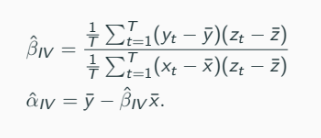Lecture 10
IV Estimation in Simple Regression
Regression Model:
yt = \alpha + \beta xt + u_tAssumption: {Cov}(xt, ut) ≠ 0
Existence of Instrument: Variable z_t such that:
{Cov}(xt, zt) ≠ 0 (Relevance)
{Cov}(zt, ut) = 0 (Validity)
IV Estimators:

Properties of the IV Estimator
Consistent Estimators (TS1 - TS3):
\hat{\alpha}_{IV} is a consistent estimator of \alpha
\hat{\beta}_{IV} is a consistent estimator of \beta
Statistical Inference Result:
\sqrt{T}(\hat{\beta}{IV} - \beta) \sim N(0, Var((zt - E(zt))ut)/Cov(xt, zt)^2) \text{ approximately}Conditional Variance:
If Var(ut|zt) = E(ut^2|zt) = \sigma^2 (Homoskedasticity),
Var((zt - E(zt))ut) = \sigma^2 Var(zt)
In this case,
\sqrt{T}(\hat{\beta}{IV} - \beta) \xrightarrow{d} N(0, \frac{\sigma^2 Var(zt)}{Cov(xt, zt)^2})
Other Issues Related to Stochastic Regressors
Model Specification:
Regression Model:
yt = \alpha + \beta xt + u_t
Assumptions Violations:
E[ut|xt] = 0
Var(ut|xt) = \sigma^2
(xt, ut) is iid
If E[ut|xt] \neq 0 (Exogeneity Violation):
OLS Estimator fails.
Conditional Heteroskedasticity
If Var(ut|xt) = \sigma^2t \neq \sigma^2 , the variance depends on xt .
Implications for OLS Estimator:
Unbiased:
\hat{\beta} = \frac{\sum{t=1}^T (xt - \bar{x})(yt - \bar{y})}{\sum{t=1}^T (x_t - \bar{x})^2}Error:
\hat{\beta} - \beta = \frac{\sum{t=1}^T (xt - \bar{x})(ut - \bar{u})}{\sum{t=1}^T (x_t - \bar{x})^2}Therefore, E[\hat{\beta} - \beta|x_t] = 0
Variance of the OLS Estimator:
When no conditional heteroskedasticity:
Var(\hat{\beta}|xt) = \sigma^2 \frac{1}{\sum{t=1}^T (x_t - \bar{x})^2}Estimated by s^2 instead of \sigma^2
Statistical Inference under Heteroskedasticity
Use of Robust Standard Errors:
Remedies for heteroskedasticity: use White’s or HAC Standard Errors.
Hypothesis Testing and Confidence Intervals are then valid.
Conditional Autocorrelation
Definition:
Correlation of Errors:
Cor(ut, us) = \frac{Cov(ut, us)}{\sqrt{Var(ut)Var(us)}}Implies OLS Estimator is unbiased but requires a careful derivation for the standard error.
Basics on Time Series
Importance in Economics:
Key Models: - Autocorrelation in linear regression framework must be understood.
Autocovariance and Autocorrelation
Definitions:
Autocovariance:
\gamma{t,s} = E[(Xt - \mu)(X_s - \mu)]Autocorrelation:
\rho{t,s} = \frac{\gamma{t,s}}{\sigma^2}
Stationary Time Series
Definitions of Stationarity:
Strictly Stationary: Joint distributions invariant under time shifts.
Weakly Stationary: Mean, Variance constant, Autocovariance depends only on lag.
Autocovariance Function:
\gamma(h) = E((Xh - \mu)(X0 - \mu))
Examples of Time Series Models
White Noise:
E(Xt) = 0 and Var(Xt) = \sigma^2Moving Average Processes (MA(1)):
Xt = \epsilont - \theta \epsilon_{t-1}
AR(p) Models
Model Specification:
Xt = \mu + \phi1 X{t-1} + \ldots + \phip X{t-p} + \epsilont
AR(1) Model and Covariance Stationary
Condition for Stationarity: |\phi1| < 1 \Rightarrow Cov(Xt) \text{ stationary}
If |\phi_1| \geq 1 , series is generally not stationary, exemplified by random walk behaviour.